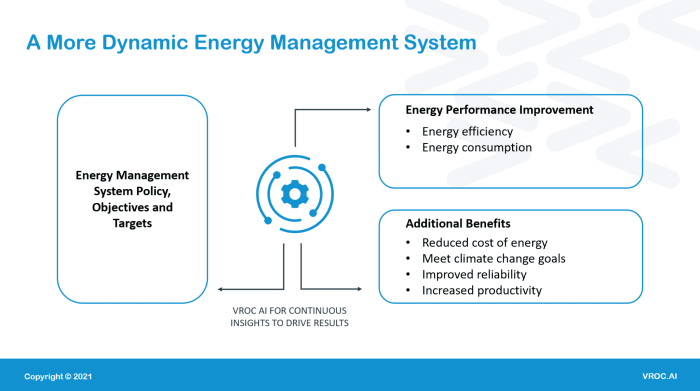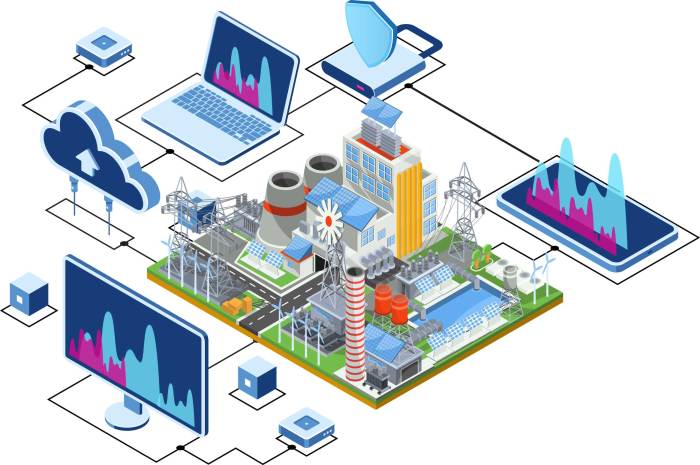Data Analytics and AI: Revolutionizing Energy Management
Data analytics and AI in energy management – In the realm of energy management, the convergence of data analytics and artificial intelligence (AI) is transforming the industry. This dynamic duo empowers organizations to optimize energy consumption, reduce costs, and enhance sustainability.
Data analytics provides the foundation for understanding energy usage patterns, while AI automates and optimizes energy management processes. Together, they create a powerful synergy that drives efficiency, innovation, and environmental stewardship.
Data Collection and Integration

Data collection and integration are crucial steps in energy management, providing a comprehensive view of energy usage. Data can be collected from various sources, including smart meters, sensors, and other devices.
Methods for Data Collection
- Smart Meters: Smart meters are advanced metering devices that measure and record energy consumption in real-time, providing granular data on energy usage patterns.
- Sensors: Sensors can be deployed to measure temperature, humidity, and other environmental factors that influence energy consumption, providing additional context for energy usage analysis.
- Building Management Systems (BMS): BMSs collect data from various building systems, including HVAC, lighting, and security, which can be integrated with energy consumption data to provide a holistic view of building operations.
- Manual Data Entry: In some cases, energy consumption data may be manually entered into a data management system, although this method is prone to errors and inconsistencies.
Data Integration and Harmonization
Data from different sources can be integrated and harmonized to create a comprehensive dataset. This involves standardizing data formats, resolving data conflicts, and ensuring data quality.
Data integration can be achieved through various methods, including data warehouses, data lakes, and data virtualization tools.
Challenges in Data Collection and Integration
Data collection and integration can be challenging due to factors such as:
- Data Quality: Data quality issues can arise from inaccurate sensors, data entry errors, and inconsistent data formats.
- Data Security: Energy consumption data can be sensitive information, and data security measures must be implemented to protect against unauthorized access.
- Data Privacy: Data privacy regulations must be considered when collecting and processing energy consumption data, particularly when it involves personal information.
Data Analysis and Visualization
Data analysis and visualization are crucial aspects of energy management, enabling the identification of patterns, trends, and insights from energy consumption data. Statistical analysis, machine learning, and data mining are common techniques employed for data analysis, while visualization techniques like charts, graphs, and dashboards help present these insights clearly and concisely.
Statistical Analysis
- Descriptive statistics provide summary measures of data, such as mean, median, and standard deviation, offering a high-level overview of energy consumption patterns.
- Inferential statistics allow for hypothesis testing and the determination of relationships between variables, helping identify factors influencing energy usage.
Machine Learning
- Machine learning algorithms can identify patterns and make predictions based on historical data, enabling the forecasting of energy consumption and the optimization of energy management strategies.
- Supervised learning techniques, such as regression and classification, are used to predict energy consumption based on known input variables.
- Unsupervised learning techniques, such as clustering and anomaly detection, can identify patterns and outliers in energy consumption data, providing insights into areas for improvement.
Data Mining
- Data mining techniques, such as association rule mining and decision tree analysis, can uncover hidden relationships and dependencies within energy consumption data.
- These techniques help identify patterns and trends that may not be apparent through traditional statistical analysis, providing valuable insights for energy management.
Data Visualization
Data visualization techniques play a vital role in communicating energy consumption patterns and trends to stakeholders. Charts, graphs, and dashboards provide a clear and concise representation of data, making it easier to identify insights and make informed decisions.
- Bar charts and line graphs are commonly used to visualize energy consumption over time, showing patterns and trends.
- Pie charts and scatter plots help visualize the distribution of energy consumption across different categories or variables.
- Dashboards provide a comprehensive overview of energy consumption data, combining multiple visualizations to present key metrics and insights.
Effective data visualization is crucial for communicating energy consumption patterns to stakeholders, including facility managers, energy engineers, and decision-makers. It enables them to understand energy usage, identify areas for improvement, and make informed decisions to optimize energy management.
AI-Powered Energy Management: Data Analytics And AI In Energy Management

Artificial intelligence (AI) is rapidly transforming the energy sector, enabling the automation and optimization of energy management processes. By leveraging AI algorithms, energy providers and consumers can enhance energy efficiency, reduce costs, and promote environmental sustainability.
To effectively harness the transformative potential of data analytics and AI in energy management, it is essential to have a robust and reliable IT infrastructure. The comprehensive guide provided in Upgrade Windows Server Essentials to a Newer Version empowers organizations to optimize their IT systems, ensuring seamless integration with data analytics and AI tools.
By upgrading to a newer version of Windows Server Essentials, businesses can leverage advanced features and enhancements that facilitate the efficient collection, analysis, and utilization of energy data, enabling informed decision-making and improved energy efficiency.
AI-powered energy management solutions employ machine learning, data analytics, and predictive modeling to analyze energy consumption patterns, forecast demand, and optimize energy usage. These solutions provide real-time insights, enabling proactive decision-making and timely interventions to improve energy efficiency.
Data analytics and AI are revolutionizing energy management, enabling us to optimize energy usage, reduce costs, and improve sustainability. Just as Mastering Bezier Paths: Craft Custom Shapes with UIShape empowers designers to create complex shapes with precision, data analytics and AI empower energy managers to craft tailored energy management strategies that meet their specific needs, enhancing efficiency and driving innovation.
Demand Forecasting
AI algorithms can analyze historical energy consumption data, weather patterns, and other relevant factors to accurately forecast energy demand. This enables energy providers to optimize generation and distribution, ensuring a reliable and efficient supply of energy to consumers.
Data analytics and AI play a crucial role in optimizing energy management, enabling real-time monitoring, predictive maintenance, and demand forecasting. While understanding these technologies is essential, expanding your knowledge in other areas can enhance your expertise. Just as Demystifying UIShape: Unraveling Its Role in iOS Development provides insights into iOS app development, exploring other domains can broaden your perspective.
This cross-disciplinary approach can empower you to tackle energy management challenges with a holistic and innovative mindset.
Load Balancing, Data analytics and AI in energy management
AI-powered load balancing systems monitor energy consumption in real-time and dynamically adjust the distribution of energy across the grid. By balancing the load, these systems reduce the risk of outages, improve grid stability, and optimize energy utilization.
Energy Efficiency Measures
AI can identify energy-intensive processes and equipment within industrial and commercial facilities. By analyzing energy consumption patterns, AI algorithms can recommend targeted energy efficiency measures, such as equipment upgrades, process optimizations, and behavioral changes, leading to significant energy savings.
Benefits of AI in Energy Management
- Improved energy efficiency
- Reduced energy costs
- Enhanced grid stability
- Reduced carbon emissions
- Optimized energy supply and demand
Challenges of AI in Energy Management
- Data quality and availability
- Algorithm selection and tuning
- Cybersecurity risks
- Integration with existing systems
- Regulatory and ethical considerations
Predictive Analytics and Forecasting

Predictive analytics involves leveraging historical and real-time data to forecast future trends and patterns. In energy management, it plays a crucial role in optimizing energy consumption, identifying anomalies, and planning for future energy needs.
Techniques Used in Predictive Analytics
Predictive analytics in energy management utilizes various techniques, including:
- Time Series Analysis: Analyzes time-dependent data to identify patterns and trends. It helps forecast future energy consumption based on historical data.
- Regression Models: Statistical models that establish relationships between variables. They can be used to predict energy consumption based on factors like weather, occupancy, and equipment usage.
- Neural Networks: Machine learning algorithms that can learn complex relationships in data. They are often used for anomaly detection and energy forecasting.
Applications of Predictive Analytics
Predictive analytics finds diverse applications in energy management, including:
- Energy Consumption Forecasting: Predicts future energy consumption patterns, enabling utilities and businesses to plan for peak demand and optimize energy procurement.
- Anomaly Detection: Identifies unusual energy consumption patterns that may indicate equipment malfunctions or energy theft.
- Energy Procurement Optimization: Forecasts energy prices and demand to optimize energy procurement strategies and reduce costs.
Importance of Predictive Analytics
Predictive analytics empowers energy managers to make proactive decisions by providing insights into future energy needs and potential risks. It enables:
- Improved energy efficiency
- Reduced energy costs
- Enhanced reliability and resilience
- Informed planning and decision-making
Concluding Remarks
As the energy landscape continues to evolve, data analytics and AI will play an increasingly pivotal role. By harnessing the power of data and AI, organizations can unlock unprecedented opportunities to manage energy consumption, reduce costs, and contribute to a more sustainable future.





